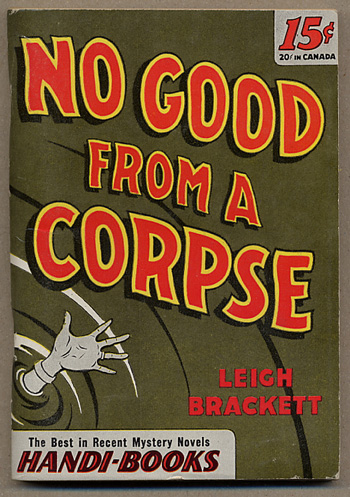OHIO CONNECTION: Resident
Kinsman

Born in Los Angeles, California, on December 7, 1915, writer Leigh Brackett, the beloved “Queen of Space Opera,” was the only child of William Franklin (an accountant) and Margaret Brackett (née Douglass). Through the distaff side, she was of Scotch, Mohawk and Sioux descent. Franklin’s death during the 1918 Pandemic necessitated that Margaret and three-year-old Leigh move in with her maternal grandfather, Archibald Douglas, into his remote Santa Monica beachfront home. A petite, muscular, sunburned tomboy, she roamed the beach pretending to be a pirate. Because of her brash, rebellious behavior and tendency to brawl with anyone who irked her, Brackett often received a paddling with the flat side of an ivory hairbrush by her exasperated grandmother. By the time she turned nine, Brackett was a voracious listener of sci-fi programs on the radio and reader of sci-fi/fantasy fiction. She was bowled over by the works of Robert E. Howard, Catherine Lucille “C.L.” Moore, and Edgar Rice Burroughs (particularly his stories featuring John Carter of Mars). Brackett became a die-hard fan of the genre. She completed four years of high school coursework in three and graduated early but was precluded from accepting a college scholarship by the family’s straightened circumstances. Brackett contributed by working as a swimming instructor at Muscle Beach.
Encouraged by her grandfather (who, as a teenager, she came to adore after growing up disliking him), Brackett tried to sell stories in multiple genres to leading publications such as Adventure Magazine (the country’s most prestigious and critically acclaimed pulp) and Argosy. When competition proved too cut-throat between herself and established writers, Brackett pursued a different avenue. She signed up with the Laurence D’Orsay Literary Agency in Los Angeles. Among the agency’s readers was D’Orsay’s nephew by marriage, sci-fi/fantasy writer Henry “Hank” Kuttner, husband to C.L. Moore. Kuttner, a friend of H. P. Lovecraft, was a member of the “Lovecraft Circle” who contributed crucial elements to the Cthulhu Mythos. Casting a critical eye over submissions, Kuttner recognized Brackett’s potential and championed her work. Outside of convincing her to focus on science fiction and fantasy and providing exemplars of the genres to study, he offered constructive criticism and had his own agent, Julius Schwartz of the Los Angeles Science Fiction Society, take her on as a client. Kuttner also introduced Brackett to such luminaries as Ray Bradbury, Jack Forrest Ackerman, and Robert A. Heinlein.
Brackett’s first short story, “Martian Quest,” appeared in the February 1940 issue of Astounding Science-Fiction magazine when she was twenty-five. By 1945, she had become a prolific contributor to such pulps as Astonishing Stories, Comet, Planet Stories, Super Science Stories, and Thrilling Wonder Stories. Her first novel, No Good from a Corpse, was published in 1943 to critical and popular acclaim.
Ultimately, Brackett left D’Orsay to join the Myron Selznick agency where she was teamed up with agent Hugh King. When he later became a story editor for Republic Pictures, King secured for her a screenwriting job (The Vampire’s Ghost, 1945) when the studio decided to follow Universal Pictures’ lead in cashing-in on the horror craze.
Impressed by No Good from a Corpse, Hollywood director Howard Hawks (Scarface, Bringing Up Baby, Sergeant York, To Have and Have Not) decided that its writer was the perfect candidate to collaborate with Pulitzer Prize winning novelist William Faulkner on the screenplay to his upcoming cinematic adaptation of Raymond Chandler’s Philip Marlowe novel, The Big Sleep. Shocked that Brackett was a woman and not a man, Hawks nevertheless had her meet with Faulkner, who, before even meeting or speaking with her, unilaterally determined the extent of her involvement. He assigned her a set number of book chapters and took responsibility for the rest himself. He never met or spoke with her again. When she was done, she turned in her work to Hawks. Brackett is quoted as saying “…Hawks and I kind of tuned in on the same channel with regard to the characters, and I think this is probably one reason that I worked with him so long. He was able to get out of me what he wanted because I had somewhat the same attitude towards the characters as he did” (Backstory 2: Interviews with Screenwriters of the 1940s and 1950s. McGilligan, 1997)
In 1946, Brackett married author Edmond Hamilton with Brackett’s close friend, Ray Bradbury, serving as best man. Born in Youngstown, Ohio, in 1904, Hamilton by age fourteen had completed high school and entered Westminster College in New Wilmington, Pennsylvania. A sci-fi/fantasy enthusiast, Hamilton’s first short story, “The Monster-God of Mamurth,” was published in the August 1926 issue of Weird Tales. Other stories were accepted and printed in quick succession. An established author in his twenties, Hamilton wrote in the space opera style of E. E. “Doc” Smith and featured intergalactic menaces, space armadas, and planetary destruction. Among George Lucas’ major influences, Hamilton is credited with establishing the use of space suits, depicting the first spacewalk, and conceiving the light saber.
In 1950, the couple bought a farmhouse built in 1819 in Kinsman, Ohio, to which they needed to install both electricity and plumbing. Brackett and Hamilton began to divide their time between their primary residence in Kinsman and their winter retreat in California’s Antelope Valley. While in Ohio, Brackett would gather wild blackberries and strawberries, and make jam, but she refused to go hunting. Most of her output at that time consisted of teleplays for such series as Alfred Hitchcock Presents, Checkmate, and Suspense.
The second of what eventually became five collaborations between Brackett and director Howard Hawks was Rio Lobo, which she co-wrote with Jules Furthman. Initially, Brackett had written “… the best script I have ever written, and Howard liked it, the studio liked it, (John) Wayne liked it, and I was delighted. We didn’t make it, because he (Hawks) decided to go back and do Rio Bravo over again.” When the film proved to be a critical and popular juggernaut, Hawks signed Brackett to a multi-film deal with each featuring John Wayne: Hatari (1962), El Dorado (1967), and Rio Lobo (1970).
In 1972, producers Jerry Bick and Elliott Kastner hired her to adapt Raymond Chandler’s novel, The Long Goodbye, a comeback vehicle for actor Elliott Gould.
In 1977, George Lucas, a longstanding fan of both Brackett and Hamilton’s writings, reached out to her about collaborating with him on what ultimately became The Empire Strikes Back. The pair had several story conferences to hash out a basic plotline. Brackett, dying from cancer, worked through her suffering to write a script. Shortly after submitting it to Lucas, she succumbed, dying on March 18, 1978, at the age of sixty-two.
Published in 2016, Brackett’s script—which previously could only have been viewed at the Jack Williamson Special Collections Library at Eastern New Mexico University in Portales, New Mexico, or at Lucasfilm archives in California—was made publicly available.
Sources and Additional Resources
Gay, Bob and Dan Neyer. 2012. “The Edmond Hamilton Collection.” Writings.
Liukkonen, Petri and Ari Pesonen. 2016. “Leigh (Douglass) Brackett (1915-1978).” Books and Writers.
Smith, Kevin Burton. 2020, Aug. 2. “Leigh Brackett.” The New Thrilling Detective Website.
Virginia. 2018, Nov. 7. “The Astounding Leigh Brackett.” Central Rappahannock Regional Library.




